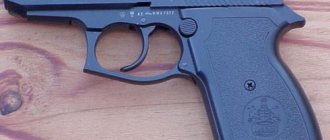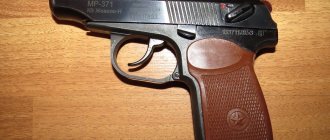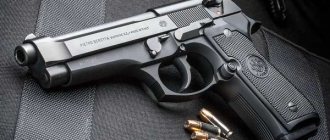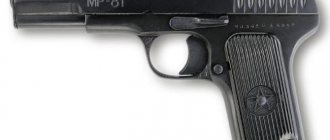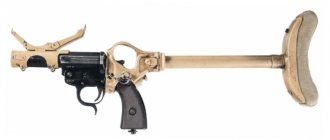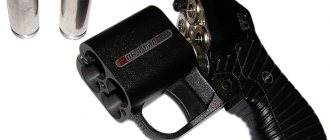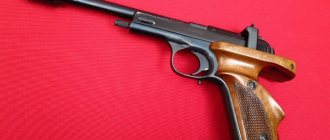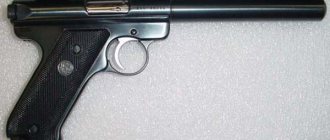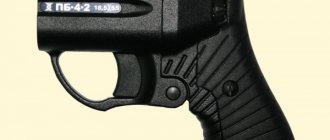Home | Weapons | Pistols | Germany | Borchardt C93
The first working model of the pistol appeared in early 1893. In the same year, its design was patented in England, and then in nine more countries, including Germany, France, Italy and the USA. In 1895, in Russia, at the request of process engineers Kaupe and Chekalov, G. Borchardt was issued a privilege (patent) for a period of 10 years for a “Repeat pistol with a rebound action.”
In 1890, Borchardt visited the company of Ludwig Lewe, where the novice designer Georg Luger was already working, but no one could have imagined then that their two names would become famous throughout the world. Shortly after visiting Lewe's factory, Borchardt began working on creating a self-loading pistol. A patent for the original development of this type of weapon was issued to him in Germany on September 9, 1893. One of the directors of the company, Ludwig Lewe, decided to make a sample of the Borchardt pistol as an experiment. Work on the new pistol lasted about 18 months.
The principle of automation based on the recoil of the barrel and the type of locking assembly of the pistol with automatic cocking of the striker in the rollback of the moving parts bear clear signs of borrowing from the Hiram Maxim machine gun. However, this borrowing is creative because Borchardt changed the position of the crank and connecting rod compared to Maxim’s machine gun, turning them 180 degrees and covering the pistol’s receiver with a bolt assembly. Later, the crank mechanism of the shutter was changed in a similar way during the modernization of the Maxim machine gun at the Vickers factories.
Leve's company immediately offered Hugo Borchardt a pistol for arming the American army. From approximately June 1893 to January 1896, Lieutenant Robert Evans was in Berlin to negotiate with the company of L. Leve and H. Borchardt about the possibility of purchasing this pistol. Evans was the first American officer to conduct detailed tests of the Borchardt pistol in 1894-1895.
In a report letter to the government, dated 1894, he wrote: “We have found a very relevant, small-sized and excellent shooting model. Its grip is close to the center of gravity and therefore it is much better balanced than any revolver I know. It seems to me that this type of weapon can be a completely worthy replacement for old revolvers...” Evans fired more than 6,000 shots from the pistol and was conquered by it. Most of all, he liked the rate of fire, as well as its excellent ballistic data, despite its short length. However, the pistol was not adopted by the American army.
Borchardt C93 pistol with holster-stock
The sailors continued the tests. According to materials from the Boston Herald, on November 22, 1894, official tests of the “Borchardt system pistol-carbine” took place by naval officers in Newport. But despite the fact that they did not accept the pistol for service, the most important fact for the designer and Leve’s company was that this pistol was officially tested by the US government.
Based on the results of these tests, Borchardt slightly improved his model, reducing the total number of parts. Thus, it now took only about 40 seconds to disassemble the pistol and about 140 to assemble it. The rate of fire of the new model has also increased. If from the first model of the pistol the shooter fired about 40 shots in 68 seconds, hitting 39 targets, then from the second model he fired 40 shots in 45 seconds, hitting more than 35 targets. For comparison, with a revolver, in the same tests, he was able to fire 32 shots in 38 seconds, hitting only 12 targets. Successful shooting from a pistol-carbine was carried out at a distance of up to 457 meters, inaccessible to old revolvers. At the same time, the convenience of the wooden butt was noted. A total of 2,448 shots were fired from the pistol-carbine without causing any serious problems.
While there was an ongoing fuss in America about testing a new type of weapon, Borchardt and his colleagues presented their pistol to the Swiss armed forces. The Swiss were at that time the first European country to be seriously interested in self-loading pistols - it was in Switzerland that the self-loading pistols of Mannlicher and Bergman were released. In the summer of 1897, the Swiss convened a special commission to consider the issue of adopting a self-loading pistol for the officers of their army. Models of pistols from Mannlicher, Bergman, Borchardt and Mauser were presented to the commission. Preference was given to the Borchardt and Mauser systems.
These tests ended in nothing, partly due to the fact that the required amount of ammunition was not found for a full shooting program, and partly due to the unpreparedness of this commission to make any serious decisions. Comparison of the characteristics of Borchardt cartridges and cartridges used in revolvers mod. 1882 was clearly in favor of the former.
In Russia, the Borchardt C93 pistol received a reserved rating. From documents from 1898 it follows that when tested by the GAU commission, the pistol functioned properly only with well-lubricated parts. When it became dirty and dusty, it began to fail. In the conclusions of the commission, in particular, about
Here is how, for example, the Russian cavalry officer, Captain Baron Kaulbars, assessed the Borchardt and Mauser pistols:
“The Borchardt pistol, in contrast to other systems, has the convenience that:
- It can be charged in two seconds in the dark.
- With a full magazine, it is still not loaded and the hammer is not cocked, while the Mauser is loaded and the hammer is cocked.
- Borchardt is unloaded in one second, and the Mauser can only be unloaded by shots or by opening the bolt and pouring cartridges into the hand one by one, using the bolt of the clip, which, however, is no longer needed for new loading.”
By the way, 60 rubles in silver in those days was a lot of money. In 1890, this is what a factory foreman earned in six months!
The Borchard K93 pistol was never produced in large quantities; it is believed that approximately 3,000 copies of this weapon were produced in total.
At the same time, five main types of Borchardt (IV) pistol can be distinguished. In addition, there were so-called transitional models of the Borchard K93 pistol, which had the features of two or more varieties.
Main varieties
- I and II. Pistols with a short (154 mm) or long (190 mm) barrel, produced as prototypes. Known serial numbers of these varieties: with a short table - 6,8, with a long table - 3,4,7,17,25
- III. Pistols from the period of preparation for mass production. Known serial numbers for this variety: 13.27.
- IV. Weapons manufactured by Loewe. Serial numbers for this variety are 19, 27 and up to approximately 110.
- V. Weapons produced by DWM, manufactured after 1896. Serial numbers of this variety range from approximately 110 to 3000.
Links[edit]
- ^ ab Antaris, Leonardo M. (2017). "At first". American shooter
.
National Rifle Association. 165
(10): 76 and 77. - Bull, Stephen (2004). Encyclopedia of Military Equipment and Innovation
. Greenwood Publishing Group. paragraph 45. ISBN 1573565571.
- Hertz, Joachim and Sturgess, Geoffrey Borchardt and Luger, Automatic Pistols
, Brad Simpson and G.L. Sturgess, 2010 and 2011, ISBN 978-0-9727815-8-9. - Hogg, Ian and Weeks, John, Pistols of the World, Completely Revised, 3rd Edition
. DBI Books, Inc., 1992, ISBN 0-87349-128-9. - Springfield Armory Museum - Collection Record, PISTOL, SEMI-AUTOMATIC - GERMAN BORCHARDT PISTOL MODEL 1894 7.63mm SN #649, * Henrotin, Gerard Description of the Borchardt Pistol, HLebooks.com, 2011 IDCFile=/spring/DETAILS.IDC, SPECIFIC= 9, DATABASE = objects,
Technical characteristics of the Borchardt C93 pistol
- Caliber: 7.65×25mm Borchardt
- Weight of the pistol with a magazine without cartridges and without an attached stock: 1,270 kg
- Weight of the pistol with a magazine without cartridges and with an attached butt: 1,720 kg
- Pistol length without stock: 352 mm
- Pistol length with butt: 680 mm
- Gun height: 137 mm
- Gun width: 47 mm
- Magazine capacity: 8 rounds
- Barrel length: 190 mm
- Initial bullet speed: 430 m/s
Subsequently, the path begun in 1893 by Hugo Borchardt was completed by Georg Luger and his very successful pistol of the 1900 model.
Pistols
- Israel
- Spain
- Mexico
- South Korea
- Slovakia
- South Africa
- Montenegro
- Croatia
- Japan
- Norway
- Ukraine
- Vietnam
- USA
- Great Britain
- Finland
- Hungary
- Germany
- Serbia
- Switzerland
- Poland
- France
- Belgium
- Italy
- Austria
- Russia/USSR
- Brazil
- Türkiye
- Argentina
- Canada
- UAE
- Jordan
- China
- Bulgaria
- Slovenia
- Czech
Design and history[edit]
The pistol used a toggle locking system, which meant that when firing the two-piece, the arm would rise and flex as the pistol recoil, allowing the bolt to unlock and release the empty cartridge case. [2]
DWM hired Georg Luger to promote the Borchardt pistol in military and commercial channels. The pistol was tested by the US Navy back in 1894, and then by the US Army. Although it was accurate and its rate of fire was high, the Borchardt pistol was expensive to manufacture and unwieldy to handle due to its near-vertical grip and weight distribution. Moreover, its recoil was unexpectedly powerful. These criticisms were noted during field trials with the Swiss Army. However, Borchardt refused to make any changes to his original design. DWM then commissioned Georg Luger to make the required improvements to the pistol. Luger took Borchardt's design, using a shorter 7.65×21mm Parabellum cartridge, which allowed him to combine a shorter rocker throw with a narrower angled grip. Luger's design eventually became the Luger Parabellum pistol. [1]
The cartridge used in the Borchardt C93 pistol was the basis for the main cartridge used in the Mauser C96 pistol (7.63×25mm Mauser); they are the same dimensions, but the 7.63mm Mauser generally had a more powerful powder charge (modern loading data showed it consumed about 20% more powder than the Borchardt) and is considered too robust for use in the Borchardt C93. However, some manufacturers' cartridges were marked "For Borchardt and Mauser automatic pistols."
The Borchardt C93 was produced and sold exclusively in Borchardt's proprietary 7.65×25mm caliber. Some test models were chambered in 7.65×21mm Parabellum and 9×18mm Borchardt, an experimental bottleneck cartridge developed in 1902.
Description of the pistol
Borchard patented a new pistol in 1893, tried to place its production at the Liege “Fabric National” and only then reached an agreement with the Berlin manufacturer Ludwig Löwe. The Borchard pistol used a hinged lever bolt, which was later used by Georg Luger for his “Parabellum”. The idea of such a device for a locking mechanism was suggested to Borchard by the design of the Maxim machine gun, which appeared during demonstration tests in Hungary just at the time when the designer lived in this country. ane.
When this system operated in the Borchard pistol, the hinged levers of the locking mechanism rose upward and then returned to their place under the action of a clock-like return spring placed in the significant in size to the casing at the back of the frame. Another innovation was the placement of the magazine in the grip, the result of Borchardt's collaboration with James Lee, an American rifle designer.
A pistol with an overweight rear part and a handle located almost at a right angle to the barrel looked rather awkward, but in fact the handle, located close to the center of gravity of the weapon, gave it good stability when shooting. This pistol was described as a high-precision, easy-to-handle weapon with low recoil force. The pistol was sold complete with a detachable stock, which turned it into a lightweight carbine that accurately hit targets at a distance of up to 200 yards.
Borchard's design earned him fame and respect among gunsmiths, but the pistol's commercial success was hampered by its high price and size. The first pistols, the production of which Loewe mastered in 1894, were equipped with the inscription “WAFFENFAB-RIK/LOEWE/BERLIN”, which consisted of three lines and was written on the chamber. On the right side of the frame was written “SYSTEM BORCHARDT PATENT”, and on the connecting lever there was a stamp “DRP 75837”.
Until January 1, 1897, more than 1000 of these pistols were produced. Löwe then took over Deutsche Metall-Patronenfabrik in Karlsruhe and renamed his new consortium Deutsche Waffen und Munition-Sfabriken. Pistols produced after January 1897 were marked “SYSTEM BORCHARDT/DEUTCHE WAFFEN UND MUNITIONSFABRIKEN/BERLIN”, running in three lines on the right side of the frame. The mark on the lever with the patent number was preserved. In 1899, the assembly of these weapons was stopped.
The Borchard pistol was produced only in one modification with a barrel 152 mm long, with a chamber for the Borchard cartridge of caliber (7.63 mm) and an eight-round magazine.
In the dictionary Dictionary of foreign words
Automatic rapid-fire pistol of a special system.||Avg. BROWNING" title='BROWNING, BROWNING is, what is BROWNING, BROWNING interpretation'>BROWNING, BULLDOG" title='BULLDOG, BULLDOG is, what is BULLDOG, BULLDOG interpretation'>BULLDOG, WALTER" title='WALTER, WALTER is, what is WALTER, WALTER interpretation'>WALTER, COLT" title='COLT, COLT this, what is COLT, COLT interpretation'>COLT, MAUSER" title='MAUSER, MAUSER this, what is MAUSER, MAUSER interpretation'>MAUSER, Nagan" title='NAGAN, Nagan this, what is Nagan, Nagan interpretation'>NAGAN, REVOLVER" title='REVOLVER, REVOLVER this, what is REVOLVER, REVOLVER interpretation'>REVOLVER. Share the meaning of the word:
Contemporary assessments
The appearance of the Borchardt C-93 pistol caused a flood of rave reviews in the press. That time period is characterized by numerous attempts by arms companies to create, as opposed to revolvers, weapons in which the reloading process would be carried out using the energy of a shot. But all of them, compared to the unexpectedly appeared Borchardt C-93 pistol, looked very mediocre.
Here is how, for example, the Russian cavalry officer, Captain Baron Kaulbars, assessed the Borchardt and Mauser pistols:
“The Borchardt pistol, in contrast to other systems, has the convenience that:
1. It can be charged in two seconds in the dark.
2. With a full magazine, it is still not loaded and the hammer is not cocked, while the Mauser is loaded and the hammer is cocked.
3. “Borchardt” is discharged in one second, but “Mauser” can only be discharged by shots or by opening the bolt and pouring cartridges into the hand one by one, using the bolt of the clip, which, however, is no longer needed for new loading.”
At the same time, the Borchardt C-93 pistol looked rather awkward due to the butt plate of the frame protruding far back and the casing covering the return spring. The absence of a bolt stop and an indicator of the presence of a cartridge in the chamber does not allow you to control the consumption of ammunition and determine whether the pistol is loaded. The asymmetrical arrangement of the trigger guard and trigger (they are offset to the left relative to the bore, probably for better ergonomics) makes the pistol difficult to use by a left-handed shooter or in the event of a wound in the right hand. Disadvantages of the design of the lever-hinged mechanism: the presence of three removable axes that are not fixed by anything other than the receiver, fastening the entire bolt assembly, makes disassembling the pistol in the field dangerous due to the possibility of losing the axes. In addition, when manually cocking the bolt of a pistol, the bolt does not always lock due to the fact that the levers do not always fully straighten and reach the “dead point,” especially when the pistol mechanism is dirty. The presence of two screws and over seventy parts makes disassembling the gun for cleaning and troubleshooting difficult. In addition, the large mass and length of the pistol do not fully meet the requirements for individual short-barreled small arms.
In Russia, the Borchardt C-93 pistol received a reserved rating. From documents from 1898 it follows that when tested by the GAU commission, the pistol functioned properly only with well-lubricated parts. When it became dirty and dusty, it began to fail. The commission's findings, in particular, noted:
“...Complete disassembly and reassembly of a pistol requires such skill and is generally so difficult that their production by lower ranks cannot be allowed without a significant risk of damaging the weapon. The mechanism of the Borchardt C-93 pistol is very sensitive to the influence of dust; requires constant and abundant lubrication for proper operation... to prevent an accidental shot, it is necessary to secure the striker springs with a special fuse... due to forgetfulness or oversight, this technique will not always be observed, especially since there is no clear difference between the raised and lowered positions of the fuse..."

